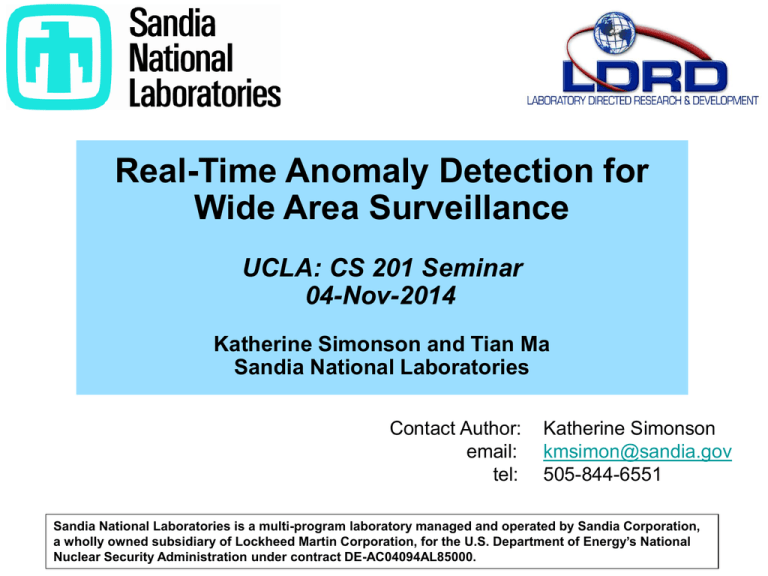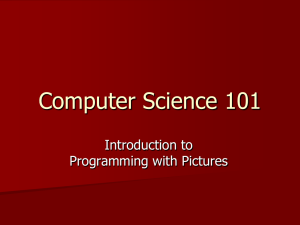
Real-Time Anomaly Detection for
Wide Area Surveillance
UCLA: CS 201 Seminar
04-Nov-2014
Katherine Simonson and Tian Ma
Sandia National Laboratories
Contact Author:
email:
tel:
Katherine Simonson
kmsimon@sandia.gov
505-844-6551
Sandia National Laboratories is a multi-program laboratory managed and operated by Sandia Corporation,
a wholly owned subsidiary of Lockheed Martin Corporation, for the U.S. Department of Energy’s National
Nuclear Security Administration under contract DE-AC04094AL85000.
Outline
Background and Mission Constraints
Mathematics of the Detector
A Few Examples
Summary and Conclusions
2
Research Goal
• Our goal is the automatic detection of small changes in wide
area surveillance.
- We work primarily with low-resolution, staring, radiometric sensors, which
are subject to significant jitter.
- Frame rates up to 75 Hz; algorithms must run causally in real time.
• We work directly with real-world data from deployed, operational,
surveillance systems.
- As well as video sequences from a range of unclassified sources.
• We are interested in detecting all physical change in the scene,
no matter how small.
- While rejecting variation due to sensor-related artifact, including pointing
drift, jitter, noise, pixel irregularities, and specularities.
3
Background Subtraction
• The standard approach to change detection involves some form
of subtraction:
- To detect new energy at time t, subtract from the frame taken at t an estimate
of the “background” energy in the scene prior to this time.
- The background estimate may be a single prior frame or a more complex
function evaluated over a window of recent frames.
• If the current frame is not properly registered to the background,
large values in the difference frame may be caused by intensity
gradients in the scene, rather than true (physical) change.
• It follows that change detection in a high jitter environment is
particularly challenging!
4
Mis-Registration
Full Image
Frame 1
Crop and add
white noise
Frame 2
Crop,
shift (r,c)+0.5,
add white noise
and 3x3 target
Frame 2 – Frame 1,
Unregistered
target
Frame 2 – Frame 1,
Registered
The difference between frames
slightly out of alignment is
dominated by scene gradients
larger than the target change.
Interpolating the second frame
into alignment with the first blurs
the target signal.
The two difference frames are
plotted in the same greyscale.
5
target signal, blurred
Sensor Artifact
Artifacts in pixel
space challenge
solutions based on
scene registration!
Bias Surface
Frame 1 + Bias,
Reduced Response
Frame 2 + Bias,
Reduced Response
target
A bias surface was
added to the original
frames, and reduced
responsiveness was
simulated in 5 pixels.
Difference Frame,
Unregistered
Difference Frame,
Registered
When Frame 2 is translated to
register with the scene of Frame 1,
the defects move out of alignment,
creating large apparent changes in
the difference frame.
All such defects must be known
and corrected for prior to scene
registration.
6
Algorithm Approach
• Frame registration cannot solve the jitter problem in real time:
- Registration to a small fraction of a pixel is required, but this precision is
often not achievable at high frame rates for low-quality data.
- Even if jitter-induced offsets are known perfectly, all sensor artifacts (fixed pattern
noise, self-emission, over- or under-responsive pixels) have to be corrected prior
to frame transformation. This may not be feasible for gradually varying artifacts.
• Our approach does not require registration, instead relying on two
separate statistical models for variations in pixel intensity.
- The temporal model handles pixels that are naturally variable due to sensor
noise or moving scene elements, along with jitter displacements comparable to
those observed in the recent past.
- The spatial model captures jitter-induced changes that may or may not have
been observed previously.
7
Outline
Background and Mission Constraints
Mathematics of the Detector
A Few Examples
Summary and Conclusions
8
Normalized Differences
• For each pixel (k, h) at time t, we test whether the observed
intensity is consistent with the spatial and temporal models. The
decision is based on simple normalized differences.
X ( k , h; t ) B( k , h; t )
Z ( k , h; t )
S( k , h; t 1)
X = pixel (k, h)’s intensity at time t,
B = current background estimate,
S = current standard deviation estimate.
• A large (absolute) value of Z(k, h; t) means the observed pixel
intensity is outside the range anticipated under the current model.
9
Decision Logic
X ( k , h; t ) B( k , h; t )
Z ( k , h; t )
S( k , h; t 1)
• Normalized differences, ZSPATIAL and ZTEMPORAL are computed using
the same background B, but different standard deviation estimates.
• If min { | ZSPATIAL|, | ZTEMPORAL| } exceeds a fixed threshold, the
observed value of the pixel at time t is inconsistent with both
models, and a candidate detection occurs.
- A one-sided test may be applied if, e.g., only positive deviations are of interest.
• Depending on the characteristics of the target changes sought,
downstream logic may be employed to reduce the false alarm rate:
- Area filtering: Require detection in at least K connected pixels.
- Duration filtering: Require detection in at least M consecutive frames.
10
Subspace Methods for Background Estimation
• Our background estimator models the manner in which pairs of
pixels vary together.
- The goal is to capture the covariance structure of a sequence of frames in a
low-dimensional, orthogonal subspace.
- If jitter and/or pointing drift are major contributors to pixel intensity changes,
we expect strong patterns of correlation between pixels.
• From a sequence of N-dimensional vectors, X(1), X(2), . . . X(t), we
could (in theory) compute the NN sample covariance matrix, CXX(t).
- Then use eigen decomposition (or SVD) to estimate the principal subspace.
- Computational issues (run-time and storage) would be significant!
- For a 2K 2K image, N = 4,000,000.
• If the background varies over time, we require a mechanism to
update the covariance matrix (and basis vectors) throughout the
frame sequence.
- This need arises in many applications and has driven development in the very
active field of adaptive subspace estimation.
11
Adaptive Subspace Estimation
• Many authors have proposed methods of subspace tracking,
beginning with Owsley (1978).
- Application to jitter suppression dates (at least) to Barry and Klop (1983).
•
Many papers are published in adaptive subspace estimation:
- Frequently cited: Oja and Karhunen (1985); Sanger (1989); Yang (1995);
Badeau et al. (2005).
- Literature reviews: Comon and Golub (1990); Doukopoulos and Moustakides (2008).
• Approaches differ in terms of computational complexity, desired
output (principal or noise subspace), tunable parameters, and
orthogonality.
- Can add a Gram-Schmidt step, with increased computational cost.
12
Subspace Background Estimates
• Let R be the dimension of the subspace representing background
energy in the scene of interest (for jitter, want R 3).
- W(t) is the NR matrix whose columns are the basis vector estimates at time t.
•
Compute the scene background estimate at time t by projecting data
vector X(t) onto the subspace spanned by the columns of W(t-1):
B(t) = W (t-1) W T(t-1) X(t)
• Changes that are consistent with those induced by jitter will lie in
(close to) the subspace, while anomalous (target) events will not.
• Suppose that pixel A correlates highly with pixels B, C, D, E and F in
frames 1 to t-1: When A increases or decreases, B – F do the same.
- At time t, if A suddenly increases but B – F do not, the change pattern will be
inconsistent with the covariance structure captured in the basis vectors.
- Pixel A will show a large projection residual for frame t.
13
FAPI Algorithm for Subspace Tracking
• Our approach uses the Fast Approximated Power Iteration (FAPI)
algorithm for subspace estimation (Badeau et al., 2005).
- Has low computational cost, O(NR), and provides orthogonal basis vectors.
• FAPI tracks the principal subspace of the data covariance, CXX(t),
without ever computing, decomposing, or storing this highdimensional matrix.
- Approximates the principal subspace of a covariance matrix that is recursively
updated using exponential weights:
CXX(t) = CXX(t-1) + X(t) XT(t)
• To track gradual change (pointing drift, cloud motion) the subspace
is updated after every frame (can perform less frequently).
- Parameter β [0, 1] controls the rate at which new data are incorporated.
Larger values of β give slower update rates.
- Can selectively slow the background update rate for pixels with large detections.
14
Background Estimation: Example
The highlighted pixel lies
along a road, and is subject to
change due to both camera
jitter and passing traffic.
Expanded View
Full Scene
The FAPI background estimate
tracks jitter closely, but gives
large residuals when a dark
vehicle moves through.
Time History, Pixel (256, 54)
Pixel intensity
FAPI background
jitter induced
jitter induced
dark vehicle
15
Temporal Variances
• “Temporal” estimates of pixel variance are based on a recent time
window of projection residuals. They are computed as follows:
1. Initialize with the sample variance over the first n frames, V(k,h;n).
2. For subsequent frames, update using:
V(k,h;t) = (1 - )[X(k,h;t) – B(k,h;t)]2 + V(k,h;t-1)
• Forgetting factor γ [0,1] determines how rapidly the filter
responds to new energy.
- As with the background estimate, the temporal variance estimate for any pixel
showing a strong detection can be selectively updated at a slower rate.
16
Spatial Estimation: Motivation
• As long as the jitter distribution is relatively stable, the temporal
approach to variance estimation provides reasonable scale factors.
• For non-stationary jitter, temporal estimates are inadequate: when
jitter increases, false alarms occur along scene gradients.
- Subspace projection alone does not solve this problem !
Key Observation: You do not need to observe line-of-sight
jitter to predict which pixels will be influenced !
• We have developed a new mathematical concept for pixel variance
estimation. Our “spatial” approach produces estimates that are
robust to non-stationary jitter, based on a single frame.
17
Bilinear Interpolation
• The method operates over a grid of conditional expectations in
the vicinity of each pixel.
• At time t-1, define:
v1 = value at pixel (k,h)
v2, v3, v4 = values at nearby pixels
• If we knew that jitter between times t-1
and t was exactly dr rows and dc columns,
we could use bilinear interpolation to
estimate the background at pixel (k,h)
at time t:
v4
v3
k+1
dc
dr
k
v1
v2
h
h+1
k-1
h-1
E(k,h; t) = v1 + dr (v3-v1) + dc (v2-v1) + drdc (v1+v4-v2-v3)
• If (dr, dc) is unknown, we can use its statistical distribution to estimate
the mean and variance of each pixel at time t as a function of
pixel values at time t-1 (or other previous frame).
18
Conditional Expectation
P(1,-2)
P(1,1)
P(0,-1)
• For each “cell” near (k,h), we use an
assumed jitter distribution to
compute:
1) The probability of jittering into this cell
at time t, and:
P(0,0)
2) The expected pixel value (and its square)
at t, given jitter into this cell.
P(-1,-1) P(-1,0)
P(-2,-2)
P(-2,1)
• After much algebra (see SAND
report), we apply the Law of Total
Probability to estimate the
variance of each pixel at time t.
• Estimates computed in this manner are surprisingly robust to misspecification of the jitter distribution: They scale roughly linearly with the
jitter standard deviation parameter (sigma).
19
- A good strategy is to set sigma conservatively (based on the worst jitter
expected) and re-scale on a per-frame basis.
Incorporating SSP and Spatial Variances
Difference Frame,
Frame 2 + Bias,
Reduced Response Unregistered
Difference Frame,
Registered
Raw SSP Residuals
target
The principal subspace was estimated
from 100 simulated jittered, noise-added
versions of Frame 1 (with bias surface
and reduced responsiveness).
SSP residuals show less scene structure
than the unregistered frame differences,
and exhibit no sensor artifact.
After division by spatial standard
deviations, the nine target pixels have
values between 1.51 and 4.55, larger than
ALL non-target pixels.
20
Spatial StDevs
Normalized
SSP Residuals
Outline
Background and Mission Constraints
Mathematics of the Detector
A Few Examples
Summary and Conclusions
21
Example 1 – Kirtland AFB
30 Hz video showing various activities near Sandia’s robotic vehicle range.
Red dots show pixels with at least one detection in frames 2400 – 3800, using
the dual-variance (spatial & temporal) model.
Detection threshold = 6.0
birds in flight
vehicles
false alarms
(scintillation)
vehicle
dismount
false alarms
22
KAFB Example: Single-Model Detections
Detections, Temporal Variances Only
Frames 2400 – 3800
Detection Threshold = 6.0
When only temporal estimates of
pixel variance are available, false
alarms occur at scene edges:
bright clouds, roads, vegetation,
and the horizon.
Detections, Spatial Variances Only
When background differences are
normalized with spatial standard
deviation estimates only, sensor
noise induces false alarms in
relatively uniform parts of the
scene.
23
KAFB Video with Detections
24
Red boxes indicate pixel detections; no tracker is applied.
Detector Response
Time History, Pixel (256, 54)
Pixel intensity
FAPI background
While the decreased
intensity due to
jitter (pink arrow) is
almost as low as the
drop due to a dark
vehicle passing
through the pixel
(blue arrow), the
detector responds
differently to jitter
and signal.
Detector Response, Pixel (256, 54)
+ 6 limit
- 6 limit
25
Detecting Birds in Flight
Detected Pixels, frames 2891 - 2900
Frame 2891
Frame 2892
Frame 2893
Frame 2894
Frame 2895
Frame 2896
Frame 2897
Frame 2898
Frame 2899
Frame 2900
A bird in flight is
detected in seven
frames.
26
Example 2 - Border Camera Footage
• Video from a surveillance camera on the Texas/Mexico border.
- Downloaded from “Virtual Border Watch”, a live video streaming website
operated by the Texas Border Sherriff’s Coalition and Bluservo.net.
- Network of pole-mounted surveillance cameras operating in the visible during
daytime hours and infrared at night.
27
Nighttime Scene Along River
10 Hz infrared video sample; nighttime scene.
- In this example, jitter was artificially induced.
- Detector set to find only positive change: new heat sources.
Red dots show pixels with at least one detection in frames 500 – 1500,
using the dual model (temporal & spatial) approach.
false alarms over water
dismount
activity
Two dismounts emerge
from the vegetation
along the river, return to
the riverside, re-emerge,
and proceed down the
track and out of the
scene.
At times, they are lost in
the near-saturated pixels
to the right of the track.
Detection threshold = 6.0
28
Texas Border Sherriff's coalition and www.blueservo.net
Single-Model Detections
Detections, Temporal Variances Only
Frames 500 - 1500
Detection Threshold = 6.0
When only temporal estimates of
pixel variance are available, false
alarms occur at scene edges:
riverbanks and tree trunks.
Detections, Spatial Variances Only
With only spatial standard
deviation estimates, scene and
sensor noise induce false alarms
in relatively uniform parts of the
scene.
29
Border Video with Detections
30
Red boxes indicate pixel detections; no tracker is applied.
Example 3 – ZooCam
• 10 Hz video downloaded from the “Bear Cam” at the Woodland Park Zoo.
• Original video was in color – downgraded to greyscale for our analysis.
• Stable camera with no jitter; many moving scene elements (running water).
• Several birds visit the scene: both the birds and their shadows are detected.
time stamp
cropped for
analysis
moving water
small waterfall
31
ZooCam Detections
A small dark bird enters the
scene in frame #3412 and
departs in frame #3669.
bird remains
in position
With no camera jitter, temporal
standard deviation estimates
suppress most false alarms.
The spatial estimates fail to
account for pixel variability on
the moving water pixels.
Detections, Temporal Variances Only
32
bird enters
scene
Detections, Dual Model
departs
Detections, Spatial Variances Only
Detections shown for frames 3380 – 3675, Threshold = 8.0
Bird in Foreground
Frame #3691
In the last 25 frames of the video, a bird flies into the
foreground of the camera. Both the bird and its
shadow are detected.
Detection boxes shown for frame #3691, Dual Model, Threshold = 8.0
33
ZooCam Video With Detection Boxes
Frames 3380 – 3700, Threshold = 8.0
Red boxes indicate pixel detections; no tracker is applied.
34
Outline
Background and Mission Constraints
Mathematics of the Detector
A Few Examples
Summary and Conclusions
35
Run-Time Performance
• Real-time implementations of the detection algorithm described
here have been utilized for a variety of applications over the past
several years.
- The software has run on frames as large as 2k 2k, at frame rates up to 75 Hz.
• Scene background and temporal variance estimates are efficiently
updated after every frame.
- For large frames, adaptive subspace estimation (FAPI) processing runs on
specialized GPU hardware.
• Spatial variance estimates are currently updated once per second.
- Sufficient for slowly-changing background or gradual pointing drift.
- We are planning upgrades to a higher refresh rate, to enable robust change
detection even in the presence of fast pointing drift.
36
Summary
• The algorithm outlined here is designed to provide robust change
detection, even in the presence of platform jitter, pointing drift, and
significant sensor artifacts.
• The three key elements are:
1. Background modeling via adaptive subspace estimation;
2. Temporal variance estimates to track historical change;
3. Spatial variance estimates to model susceptibility to jitter and/or
pointing drift.
• The approach has proven performance in real-world operations.
• Sandia was granted a U.S. Patent for the spatial variance estimation
technique.
37
U.S. Patent No. 8,103,161, K.M. Simonson and T.J. Ma, “Estimating Pixel
Variances in the Scenes of Staring Sensors,” 24-Jan-2012.
BACKUP SLIDES
38
References
Adaptive Subspace Estimation:
1.
R. Badeau, B. David, and G. Richard, “Fast Approximated Power Iteration Subspace Tracking”, IEEE
Transactions on Signal Processing, vol. 53, no. 8, pp. 2931-2941, 2005.
2.
P.E. Barry and M. Klop, “Jitter Suppression: A Data Processing Approach,” Proceedings of the SPIE, vol.
366, pp. 2-9, 1983.
3.
P. Comon and G.H. Golub, “Tracking a Few Extreme Singular Values and Vectors in Signal Processing,”
Proceedings of the IEEE, vol. 22, no. 8, pp. 1327-1343, 1990.
4.
X.G. Doukopoulos and G.V. Moustakides, “Fast and Stable Subspace Tracking,” IEEE Transactions on
Signal Processing, vol. 56, no. 4, pp. 1452-1465, 2008.
5.
E. Oja and J. Karhunen, “On Stochastic Approximation of the Eigenvectors and Eigenvalues of the
Expectation of a Random Matrix,” J. Math Anal. and Appl., vol. 106, iss. 1, pp. 69-84, 1985.
6.
N.L. Owsley, “Adaptive Data Orthogonalization,” Proceedings of the IEEE Conference on Acoustics, Speech,
and Signal Processing, pp. 109-112, 1978.
7.
T.D. Sanger, “Optimal Unsupervised Learning in a Single-Layer Linear Feedforward Neural Network,” Neural
Networks, vol. 2, pp. 459-473, 1989.
8.
B. Yang, “Projection Approximation Subspace Tracking,” IEEE Transactions on Signal Processing, vol. 43,
pp. 95-107, 1995.
Sandia’s Anomaly Detector:
1.
39
K.M. Simonson and T.J. Ma, “Robust Real-Time Change Detection in High Jitter,” Technical Report
SAND2009-5546, Sandia National Laboratories, Albuquerque NM, 2009.
Detection Parameters
DETECTOR PARAMETER:
SETTINGS,
KAFB & Border
SETTINGS,
BearCam
FAPI Decay Rate
0.975
0.975
FAPI Decay Rate, Suppressed
0.99
0.99
Variance Decay Rate
0.99
0.99
Variance Decay Rate, Suppressed
1.0
1.0
Detection Threshold
6.0
8.0
Background Suppression Threshold
6.0
6.0
Variance Suppression Threshold
3.0
3.0
Jitter Standard Deviation
2.0
0.25
3
5
Connected Neighbors
The same parameter values were used for the KAFB and border videos. However, a
one-sided (positive deviations only) threshold was used for the infrared border
data, while a two-sided (absolute value) threshold was applied for the visible KAFB
and BearCam imagery. For the Bear Cam example, the detection threshold was
increased and the jitter standard deviation was decreased.
40









